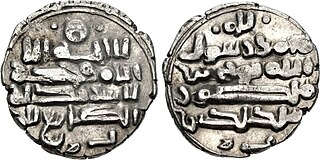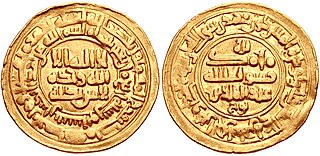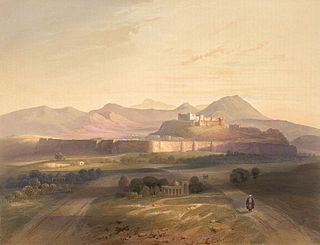Related Research Articles

Ghazni, historically known as Ghaznayn (غزنين) or Ghazna (غزنه), also transliterated as Ghuznee, and anciently known as Alexandria in Opiana, is a city in southeastern Afghanistan with a population of around 190,000 people. The city is strategically located along Highway 1, which has served as the main road between Kabul and Kandahar for thousands of years. Situated on a plateau at 2,219 metres (7,280 ft) above sea level, the city is 150 kilometres (93 mi) south of Kabul and is the capital of Ghazni Province. The name Ghazni drives from the Persian word "ganj", meaning ‘treasure’.

The Ghaznavid dynasty was a Persianate Muslim dynasty of Turkic mamluk origin. It ruled the Ghaznavid Empire or the Empire of Ghazni from 977 to 1186, which at its at its greatest extent, extended from the Oxus to the Indus Valley. The dynasty was founded by Sabuktigin upon his succession to the rule of Ghazna after the death of his father-in-law, Alp Tigin, who was an ex-general of the Samanid Empire from Balkh.

Abu Mansur Nasir ad-Din wa'd-Dawla Sabuktigin was the founder of the Ghaznavid dynasty, and amir of Ghazna from 977 to 997. Sabuktigin was a Turkic slave who was bought by Alp-Tegin, the commander of the royal guard of the Samanid dynasty. Alp-Tegin established himself as the governor of Ghazna in 962, and died a year later in 963. Afterwards, Sabuktigin built his prestige among other slave soldiers in Ghazna until he was elected by them as their ruler in 977.

Abu al-Qasim Mahmud ibn Sabuktigin, usually known as Mahmud of Ghazni or Mahmud Ghaznavi, was Sultan of the Ghaznavid Empire, ruling from 998 to 1030. During his reign and in medieval sources, he is usually known by his honorific title Yamin al-Dawla. At the time of his death, his kingdom had been transformed into an extensive military empire, which extended from northwestern Iran proper to the Punjab in the Indian subcontinent, Khwarazm in Transoxiana, and Makran.

The Samanid Empire was a Persianate Sunni Muslim empire, ruled by a dynasty of Iranian dehqan origin. The empire was centred in Khorasan and Transoxiana, at its greatest extent encompassing northeastern Iran and Central Asia, from 819 to 999.

Abd al-Malik I was amir of the Samanid Empire from 954 to 961. He was the son and successor of Nuh I. His reign was marked by internal strife, with the Turkic slave-soldiers increasing in power. He died after falling from his horse during a game of polo at Bukhara. He was succeeded by his brother Mansur I, who was put on the throne by a faction of ghulams led by the Turkic slave-commander, Fa'iq Khassa.
Nasr I was amir of the Samanids from 865 to 892. He was the son and successor of Ahmad ibn Asad.

Abu Salih Mansur, better known as Mansur I (منصور) was amir of the Samanids from 961 to 976. The son of Nuh I, his reign was characterized by weak rule and perpetual financial troubles. Mansur was notably the first Samanid ruler to the use title of King of Kings (Shahanshah), most likely as a response to his rival, the Buyid ruler Adud al-Dawla, who likewise used the title. He is also known by the sobriquet Amīr-i Sadid.

Alp-Tegin, or Alptekin, was a Turkic slave commander of the Samanid Empire, who would later become the semi-independent governor of Ghazna from 962 until his death in 963.

Muhammad of Ghazni was Sultan of the Ghaznavid Empire briefly in 1030, and then later from 1040 to 1041. He ascended the throne upon the death of his father Mahmud in 1030. He was the younger of a set of twins; this circumstance resulted in civil strife. His reign lasted five months before he was overthrown by his twin Ma'sud I, after which he was blinded and imprisoned on the order of Ma'sud I. According to Ferishta, his reign lasted only 50 days. Nine years later he was reinstated for a year before being slain by his nephew Maw'dud after losing a battle in Nangrahar.
The Farighunids were an Iranian dynasty that ruled Guzgan in the late 9th, 10th and early 11th centuries. They were ultimately deposed by the ruler of the Ghaznavid Empire, Sultan Mahmud.

Masʽud I of Ghazni, known as Amīr-i Shahīd, was sultan of the Ghaznavid Empire from 1030 to 1040. He rose to power by seizing the Ghaznavid throne from his younger twin Mohammad, who had been nominated as the heir upon the death of their father Mahmud of Ghazni. His twin was shortly blinded and imprisoned. However, when much of Masʽud's western domains had been wrested from his control, his troops rebelled against him and reinstated Mohammad to the throne.
The Battle of Ghazni was fought in 998 between the rival Ghaznavid forces of Amir Ismail and the rebel forces of his older brother Mahmud of Ghazni.
The Mikalid family, also known as the Mikalis, was a prominent Iranian aristocratic family of Khorasan from the 9th century to the 11th century. They were descended from the pre-Islamic nobility of Samarkand.
Abuʾl-Ḥasan al-Qāsim Aḥmad ibn Ḥasan Maymandī was a Persian vizier of the Ghaznavid ruler Mahmud of Ghazni and the latter's son Mas'ud I of Ghazni.
Abd al-Razzaq Maymandi was a Persian vizier of the Ghaznavid Sultan Maw'dud Ghaznavi and Abd al-Rashid.
Abu'l-Hasan Ali ibn Fadl ibn Ahmad Isfarayini, commonly known as Abu'l-Hasan Isfarayini, was a Persian vizier of the Ghaznavid sultan Mahmud of Ghazni from 998 to 1010.
Böritigin or Böri, also known as Pirai, was a Turkic officer, who served as the Samanid governor of Ghazna from 974/975 to 977.

The Lawīk dynasty was the last native dynasty which ruled Ghazni prior to the Ghaznavid conquest in the present-day Afghanistan. Lawiks were originally Hindus, but later became Muslims. They were closely related to the Hindu Shahis, and after 877, ruled under the Hindu Shahi suzerainty.
Hurra-yi Khuttali was a princess from the Ghaznavid dynasty and the daughter of Sabuktigin, ruler of Ghazna. She was married to two Ma'munid rulers of the Khwarazm region, the brothers Abu Ali Hasan and Ma'mun II. It is not known if she had any children with any of her husbands. Her marriages were a direct cause of the annexation of Khwarazm by her brother, Mahmud of Ghazni. In 1030, upon Mahmud's death, she wrote a letter to her favourite nephew, Mas'ud, urging him to claim the throne from his brother, Muhammad. After receiving her missive, Mas'ud quickly marched to Ghazna and usurped the throne. Hurra's letter is considered the most prominent political act of a woman during the Ghaznavid era. She is last mentioned in 1040, leaving Ghazna for India; her ultimate fate is unknown.
References
- ↑ "ESMĀʿĪL, b. Seboktegīn" Encyclopædia Iranica . Retrieved 18 August 2014
- ↑ "ESMĀʿĪL, b. Seboktegīn" Encyclopædia Iranica . Retrieved 18 August 2014
- ↑ Sen, Sailendra (2013). A Textbook of Medieval Indian History. Primus Books. p. 63. ISBN 978-9-38060-734-4.
- ↑ Bosworth 2012.